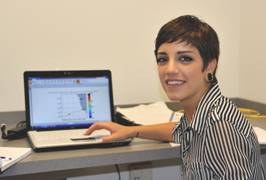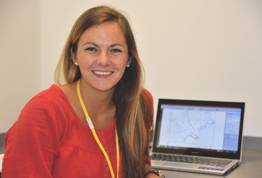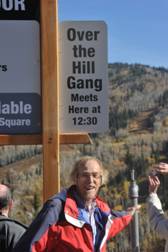Got the MAGIC in Me!
Published: 21 June 2013
Editor’s note: Ernie Lewis, principal investigator for the Marine ARM GPCI Investigations of Clouds (MAGIC) field campaign, introduces us to some MAGIC participants.
One of the great things about MAGIC for me has been the opportunity to meet and interact with many people I wouldn’t have otherwise met, from the ship’s crew to technicians to other scientists and beyond. Uniformly these people have been great to work with and to get to know, and these interactions are a very large part of what has made MAGIC so fun for me.
During the summer, Brookhaven National Laboratory allows researchers the opportunity to choose college interns to spend their summer doing research with us. Our department has had great success with this program in the past, and we hope to have continued success with this year’s two summer students: Danielle Mallon and Michelle Gostic, who started last week. Both grew up on Long Island, near Brookhaven.

Danielle recently graduated from University of Albany – SUNY (State University of New York) with a B.S. in environmental science (atmospheric concentration) and a B.A. in Earth and atmospheric science—both cum laude! She worked at NASA last summer and during her school years she worked at the school radio and TV station, including announcing the weather. Next year, she plans to get a graduate geographic information systems (GIS) certification back at UAlbany, and after that, she plans to work in air quality and eventually get a P.D in some field of atmospheric sciences.
This summer, she is learning the Python computer language. She will be looking at data from two of the aerosol instruments: the Condensation Particle Counter (CPC) and the Ultra-High Sensitivity Aerosol Particle Spectrometer (UHSAS). Each of these two instruments measures aerosol concentration (the number of aerosol particles in a given volume), but they have different size ranges. The difference between the two values gives the number concentration of aerosol particles in the intermediate size range. This is of great interest for aerosols over the ocean and one of the outstanding questions is whether the ocean produces particles in this size range from breaking waves. She might also look at data from the Particle Soot Absorption Spectrophotometer (PSAP), which measures the light-absorbing properties of aerosols at three wavelengths (i.e., colors).

Michelle just finished her sophomore year at Cornell, in Ithaca, NY, where she is majoring in environmental engineering. She worked at Cornell last summer on a project involving the effectiveness and durability of a portable foam filtration system that could be used to provide safe drinking water in rural areas. During the year, she plays club basketball and teaches classes in tree climbing. This fall she will start a year abroad in Spain. She plans to get a PhD in environmental or coastal engineering and wants to pursue a career in this field.
For her internship, she will be using—and expanding—her programming skills in MATLAB to examine data from the UHSAS and the nephelometer, an instrument that measures the scattering of light by aerosol particles at three wavelengths. In addition to the number concentration of aerosol particles, the UHSAS also gives the aerosol size distribution (the number of aerosol particles in a given size range that are in a given volume), rather like a histogram of the particle sizes. From this, the light scattering can be calculated, if certain assumptions are made, and this value can be compared with what is measured. Hopefully, the two values agree. If they do, this provides evidence that things are working as expected. If they don’t, it could be an indication that something isn’t working properly or that the assumptions that were made aren’t valid. Either way it’s an important comparison.
Both Danielle and Michelle are smart, hard working, and very pleasant to interact with. They hit the ground running and it’s already been a busy summer for them. I insist they talk to some of the senior people in the department and attend all the seminars (we had three this week). I ask them to look at clouds on their way into work and to record the weather every day. Naturally, I ask them lots of pesky questions about why we want to study what we’re studying, like how the instruments work, how clouds and raindrops behave, and all sorts of things an atmospheric scientist should know. For instance, I ask them: How big are raindrops? Why don’t clouds fall down? What is air composed of? I explained that the point of the questions is to challenge them and force them to think about the world differently. I want them to realize that it’s ok NOT to know something, but if this “something” is important, they should know how to find the answer. They’re picking it up rapidly.


Another person whose role in MAGIC cannot be overestimated is Warren Wiscombe. Warren visited Brookhaven and gave a great seminar on exoplanets, i.e., planets not in our solar system. This was his farewell seminar. Warren is retiring from NASA after many years, several of which he spent one week a month at Brookhaven. [Editor’s note: during this time he was also ARM Chief Scientist]. Some years back, he came into my office talking about MAGIC (before it was MAGIC) and asked me if I would like to be part of it—I jumped at the chance.
He and I spent a lot of time together getting it planned, getting the proposal written, and things like that. I remember we were trying to come up with an acronym for the project (this is before we chose MAGIC). We had various letters to work with: M for marine, A for ARM, G for GPCI, P for Pacific, and so on. Knowing my interest in birds, he suggested MAGPIE, which would have been a great one except for the lack of any relevance to the project. He also had an acronym that spelled out Moma Lombardi’s, a nearby restaurant that he likes.
His plans are to retire this fall and move to northern California and write books. He’s been a great friend, a fun collaborator and co-conspirator, and a great resource. I plan on seeing him this fall in California after a conference in San Francisco. Stay in touch, Warren!
–Ernie Lewis, MAGIC principal investigator
The ARM Climate Research Facility is a DOE Office of Science user facility. The ARM Facility is operated by nine DOE national laboratories, including .
Keep up with the Atmospheric Observer
Updates on ARM news, events, and opportunities delivered to your inbox
ARM User Profile
ARM welcomes users from all institutions and nations. A free ARM user account is needed to access ARM data.


















